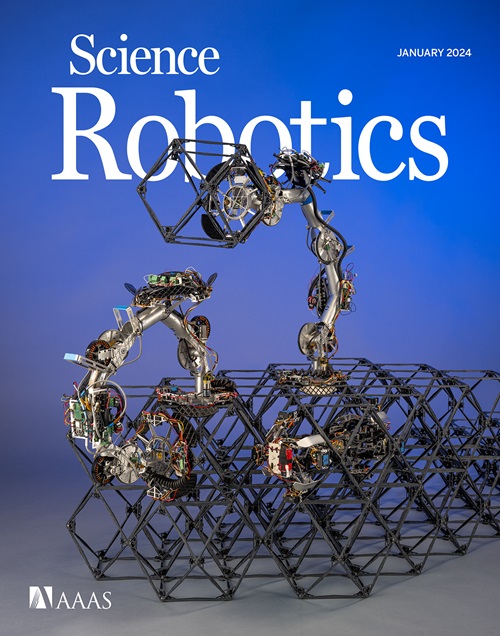爆炸供电的隐形触觉显示器
IF 27.5
1区 计算机科学
Q1 ROBOTICS
引用次数: 0
摘要
高分辨率电子触觉显示器将改变触觉,为盲人或视障人士提供远程机器操作、虚拟现实和数字信息访问。然而,提高这些显示器的分辨率需要增加单个可寻址驱动器的数量,同时减少它们的总表面积、功耗和重量,这些挑战最明显地反映在价格合理的多行盲文显示器的缺乏上。融合了软机器人、微流体和非线性力学的原理,我们引入了一个直径为2毫米的10点乘10点阵列,燃烧驱动,可逆的软致动器,每个致动器在0.24毫秒内上升,以重复产生显示图案。我们的橡胶结构是密封的,可以抵抗液体和污垢的进入。我们在一个无系绳的触觉显示原型中演示了完整的驱动周期。我们的平台技术将触觉显示器的功能扩展到传统驱动模式无法进入的环境。本文章由计算机程序翻译,如有差异,请以英文原文为准。
Explosion-powered eversible tactile displays
High-resolution electronic tactile displays stand to transform haptics for remote machine operation, virtual reality, and digital information access for people who are blind or visually impaired. Yet, increasing the resolution of these displays requires increasing the number of individually addressable actuators while simultaneously reducing their total surface area, power consumption, and weight, challenges most evidently reflected in the dearth of affordable multiline braille displays. Blending principles from soft robotics, microfluidics, and nonlinear mechanics, we introduce a 10-dot–by–10-dot array of 2-millimeter-diameter, combustion-powered, eversible soft actuators that individually rise in 0.24 milliseconds to repeatably produce display patterns. Our rubber architecture is hermetically sealed and demonstrates resistance to liquid and dirt ingress. We demonstrate complete actuation cycles in an untethered tactile display prototype. Our platform technology extends the capabilities of tactile displays to environments that are inaccessible to traditional actuation modalities.
求助全文
通过发布文献求助,成功后即可免费获取论文全文。
去求助
来源期刊

Science Robotics
Mathematics-Control and Optimization
CiteScore
30.60
自引率
2.80%
发文量
83
期刊介绍:
Science Robotics publishes original, peer-reviewed, science- or engineering-based research articles that advance the field of robotics. The journal also features editor-commissioned Reviews. An international team of academic editors holds Science Robotics articles to the same high-quality standard that is the hallmark of the Science family of journals.
Sub-topics include: actuators, advanced materials, artificial Intelligence, autonomous vehicles, bio-inspired design, exoskeletons, fabrication, field robotics, human-robot interaction, humanoids, industrial robotics, kinematics, machine learning, material science, medical technology, motion planning and control, micro- and nano-robotics, multi-robot control, sensors, service robotics, social and ethical issues, soft robotics, and space, planetary and undersea exploration.
 求助内容:
求助内容: 应助结果提醒方式:
应助结果提醒方式:


